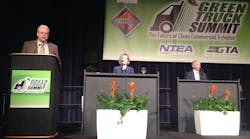INDIANAPOLIS. Speakers here on a kickoff panel of the annual Green Truck Summit, held in conjunction with this week’s NTEA Work Truck Show, made one thing clear—alternative fuels for trucking will remain a matter of considerable choice, and for years to come.
For example, Doyle Sumrall, NTEA managing director, pointed out that the “infrastructure is growing for public stations” offering a range of alternative fuels— including biodiesel, compressed natural gas (CNG) and propane autogas (LPG)—and that “fleet approaches to selecting alternative fuels remain eclectic. Natural gas remains strong, but so do others.”
“The vision of the U.S. biodiesel industry is to see 5% of the petroleum diesel used replaced with biodiesel by 2015 and 10% by 2022,” advised Jennifer Weaver, OEM Outreach & education program specialist for the National Biodiesel Board.
“That 5% alone would equal 1.88 billion gallons of biodiesel,” she continued, noting that “2013 was a banner year for biodiesel and the momentum is with it going into 2014.
Weaver said there are now 115 EPA-registered biodiesel production plants nationwide and that biodiesel and blends are now available from 630 distributors and 659 retailers as well as at 506 truckstops. “There are at least 1,995 public fueling locations for biodiesel,” she added.
According to Weaver, the future is bright in part for biodiesel simply because diesel itself is forecast to become the number-one transportation fuel globally by 2020. She noted that, per ExxonMobil, diesel will surpass gasoline globally on its way to that distinction.
And looking out to 2040, Weaver said by then “diesel will account for 70% of the growth in demand for all transportation fuels. She advised that, over the same time frame, the share held by natural gas will rise to 4% from the 1% it holds today.
Turning to a concern about biodiesel that has influenced fleet owners, Weaver pointed out that now “all OEMs selling diesel equipment in the U.S. support [the use of] at least B5 and lower-level blends and over 70% support B20 or higher in at least some of their equipment.” She added that “nearly 90% of [the] medium- and heavy truck markets support B20.”
Tucker Perkins, chief business development officer for the Propane Education & Research Council (PERC), called propane autogas “the little engine that could” as it has become an alternative fuel for numerous large fleets, including private fleets such as Frito Lay and Coca Cola as well as municipalities, that operate a diverse range of vehicles.
Perkins said sales activity for LPG-fueled vehicles reached 14,000 units in 2013, with those roughly split 50/50 between OEM orders—chiefly from Ford and GM— and aftermarket conversions. He added that the sales mix was 75% light-duty and 25% medium-duty vehicles.
“Propane autogas is not a Class 8 fuel,” he hastened to add. “It’s primarily going into light-duty pickups and vans and is moving into the medium-duty market mostly in school buses but the future includes medium-duty trucks as well.”
As to why a fleet would choose propane autogas when “all you read about is natural gas,” Perkins said it is because while LPG is produced from natural gas, it can be stored as a liquid at a low pressure.
“And,” he continued, “installing fueling infrastructure for propane autogas is a non-event—an initial cost of [approximately] $40,000 and [the system] is not expensive to maintain.”
Perkins added that while there are already some 3,000 public LPG fueling locations in the U.S., “the propane autogas industry is now also going after the centrally fueled fleets. The future [for LPG] is here and we see nothing but continuing growth across existing and other [OEM] platforms.”
Stephe Yborra, director of market development for NGVAmerica, said that the new “abundance of natural gas [in the U.S.] is driving the price differential” vs. diesel the alternative fuel is enjoying.
He noted that, per an NGVAmrica survey, there are now 142,000 natural-gas vehicles (NGVs) on the road. Of those, 33,000 to 35,000 are heavy-duty vehicles, including 7,500 tractors and 5,000 trucks engaged in port/regional applications. Another 22,000 to 24,000 are medium-duty vehicles and 83,000 are light-duties.
“There’s steady growth in both medium- and heavy-duty NGVs as OEMs are adding natural-gas fueling options,” Yborra advised. He pointed out that of the 17,450 “newly”—as the number includes re-powered units-- natural-gas vehicles that hit the road in 2012, 1,300 were Class 3-5 trucks, including utility vehicles and step vans. And 5,500 were Class 6-8 units, used mostly in refuse or transit applications but some for hauling freight.
As for fueling infrastructure, Yborra reported that the “NGV station count is now 1.425 after steady growth over the past 36 months. He noted that about half are “public access” facilities.
“CNG can handle local and some regional trucking needs and there is increasing interest in liquefied natural gas (LNG) to serve long-haul trucking,” he observed.
Yborra said to expect to see 22,000 to 25,000 more NGVs come into service in 2014. “Light-duty OEMs are focusing fleet sales on vans and pickups, but medium- and heavy-duty sales will do fine as well. He added that some 225 to 275 more NGV fueling stations will open this year.



